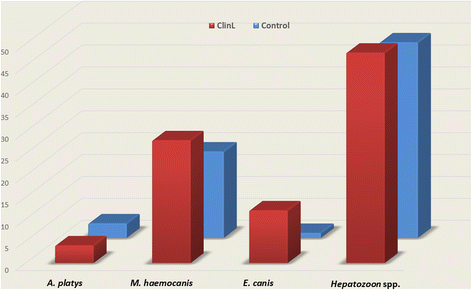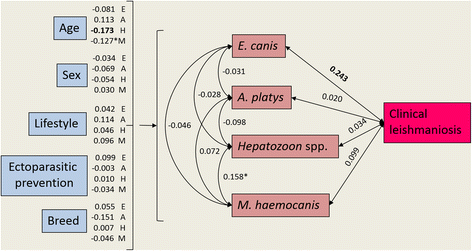Association between canine leishmaniosis and Ehrlichia canis co-infection: a prospective case-control study
- PMID: 29554932
- PMCID: PMC5859779
- DOI: 10.1186/s13071-018-2717-8
Association between canine leishmaniosis and Ehrlichia canis co-infection: a prospective case-control study
Abstract
Background: In the Mediterranean basin, Leishmania infantum is a major cause of disease in dogs, which are frequently co-infected with other vector-borne pathogens (VBP). However, the associations between dogs with clinical leishmaniosis (ClinL) and VBP co-infections have not been studied. We assessed the risk of VBP infections in dogs with ClinL and healthy controls.
Methods: We conducted a prospective case-control study of dogs with ClinL (positive qPCR and ELISA antibody for L. infantum on peripheral blood) and clinically healthy, ideally breed-, sex- and age-matched, control dogs (negative qPCR and ELISA antibody for L. infantum on peripheral blood) from Paphos, Cyprus. We obtained demographic data and all dogs underwent PCR on EDTA-blood extracted DNA for haemoplasma species, Ehrlichia/Anaplasma spp., Babesia spp., and Hepatozoon spp., with DNA sequencing to identify infecting species. We used logistic regression analysis and structural equation modelling (SEM) to evaluate the risk of VBP infections between ClinL cases and controls.
Results: From the 50 enrolled dogs with ClinL, DNA was detected in 24 (48%) for Hepatozoon spp., 14 (28%) for Mycoplasma haemocanis, 6 (12%) for Ehrlichia canis and 2 (4%) for Anaplasma platys. In the 92 enrolled control dogs, DNA was detected in 41 (45%) for Hepatozoon spp., 18 (20%) for M. haemocanis, 1 (1%) for E. canis and 3 (3%) for A. platys. No Babesia spp. or "Candidatus Mycoplasma haematoparvum" DNA was detected in any dog. No statistical differences were found between the ClinL and controls regarding age, sex, breed, lifestyle and use of ectoparasitic prevention. A significant association between ClinL and E. canis infection (OR = 12.4, 95% CI: 1.5-106.0, P = 0.022) was found compared to controls by multivariate logistic regression. This association was confirmed using SEM, which further identified that younger dogs were more likely to be infected with each of Hepatozoon spp. and M. haemocanis, and dogs with Hepatozoon spp. were more likely to be co-infected with M. haemocanis.
Conclusions: Dogs with ClinL are at a higher risk of co-infection with E. canis than clinically healthy dogs. We recommend that dogs diagnosed with ClinL should be tested for E. canis co-infection using PCR.
Keywords: Anaplasma platys; Canine leishmaniosis; Co-infection; Cyprus; Ehrlichia canis; Hepatozoon spp.; Leishmania infantum; Mycoplasma haemocanis; Structural equation model; Vector-borne pathogen.
Conflict of interest statement
Ethics approval and consent to participate
This study was ethically approved by the University of Bristol’s Animal Welfare and Ethical Review Board (Veterinary Investigation number: 15/022) as well as the Royal Veterinary Collage’s Ethics and Welfare Committee (Veterinary Investigation number: 20141292). All procedures were performed in accordance with Cypriot legislation [The Dogs LAW, N. 184 (I)/2002] following written and informed consent being obtained from all dog owners.
Consent for publication
Not applicable.
Competing interests
DM, ST, KP and CH work for the Diagnostic Laboratories, Langford Vets, University of Bristol. The Laboratories provide a range of commercial diagnostic services including PCR and qPCR testing for VBPs and ELISA testing for
Publisher’s Note
Springer Nature remains neutral with regard to jurisdictional claims in published maps and institutional affiliations.
Figures


Similar articles
-
Associations between clinical canine leishmaniosis and multiple vector-borne co-infections: a case-control serological study.BMC Vet Res. 2019 Sep 18;15(1):331. doi: 10.1186/s12917-019-2083-6. BMC Vet Res. 2019. PMID: 31533745 Free PMC article.
-
Canine tick-borne pathogens in Cyprus and a unique canine case of multiple co-infections.Ticks Tick Borne Dis. 2017 Mar;8(3):341-346. doi: 10.1016/j.ttbdis.2016.12.006. Epub 2016 Dec 26. Ticks Tick Borne Dis. 2017. PMID: 28089651 Free PMC article.
-
Does co-infection with vector-borne pathogens play a role in clinical canine leishmaniosis?Parasit Vectors. 2018 Mar 20;11(1):135. doi: 10.1186/s13071-018-2724-9. Parasit Vectors. 2018. PMID: 29554918 Free PMC article.
-
Co-infections of rickettsiales in clinically healthy, Leishmania infantum seropositive and seronegative dogs: a systematic literature review and new findings from Southern Italy.Parasitol Res. 2025 Jan 29;124(2):14. doi: 10.1007/s00436-025-08458-4. Parasitol Res. 2025. PMID: 39878800 Free PMC article.
-
An annotated checklist of tick-borne pathogens of dogs in Nigeria.Vet Parasitol Reg Stud Reports. 2019 Jan;15:100255. doi: 10.1016/j.vprsr.2018.12.001. Epub 2018 Dec 3. Vet Parasitol Reg Stud Reports. 2019. PMID: 30929932 Review.
Cited by
-
Prognostic Factors and Life Expectancy in Canine Leishmaniosis.Vet Sci. 2020 Sep 4;7(3):128. doi: 10.3390/vetsci7030128. Vet Sci. 2020. PMID: 32899831 Free PMC article.
-
Total serum IgD from healthy and sick dogs with leishmaniosis.Parasit Vectors. 2019 Mar 26;12(1):119. doi: 10.1186/s13071-019-3384-0. Parasit Vectors. 2019. PMID: 30909975 Free PMC article.
-
Epidemiologic, Clinical and Immunological Consequences of Co-Infections during Canine Leishmaniosis.Animals (Basel). 2021 Nov 10;11(11):3206. doi: 10.3390/ani11113206. Animals (Basel). 2021. PMID: 34827938 Free PMC article. Review.
-
Synthetic Peptides Selected by Immunoinformatics as Potential Tools for the Specific Diagnosis of Canine Visceral Leishmaniasis.Microorganisms. 2024 Apr 30;12(5):906. doi: 10.3390/microorganisms12050906. Microorganisms. 2024. PMID: 38792746 Free PMC article.
-
[Circulación de Leishmania infantum y Trypanosoma cruzi en perros domésticos de áreas urbanas de Sincelejo, región Caribe de Colombia].Biomedica. 2022 Dec 1;42(4):633-649. doi: 10.7705/biomedica.6369. Biomedica. 2022. PMID: 36511676 Free PMC article. Spanish.
References
-
- Vrhovec MG, Pantchev N, Failing K, Bauer C, Travers-Martin N, Zahner H. Retrospective analysis of canine vector-borne diseases (CVBD) in Germany with emphasis on the endemicity and risk factors of leishmaniosis. Parasitol Res. 2017;116(Suppl. 1):131–144. doi: 10.1007/s00436-017-5499-6. - DOI - PubMed
Publication types
MeSH terms
Substances
Grants and funding
LinkOut - more resources
Full Text Sources
Other Literature Sources
Medical
Miscellaneous

